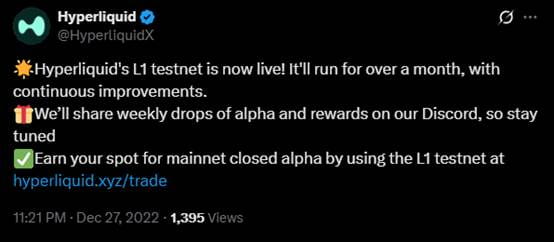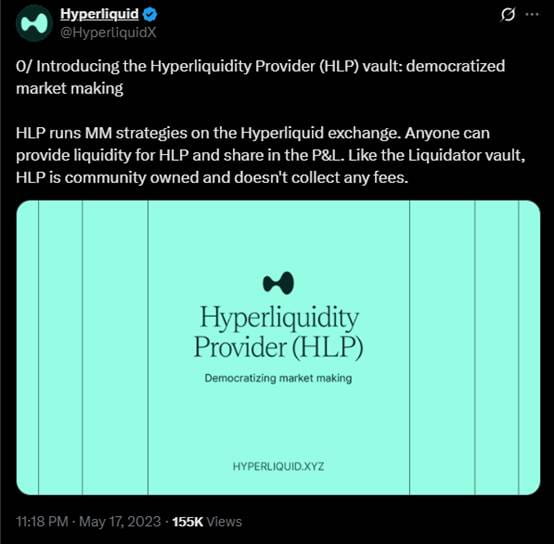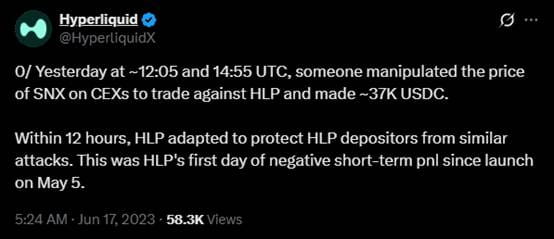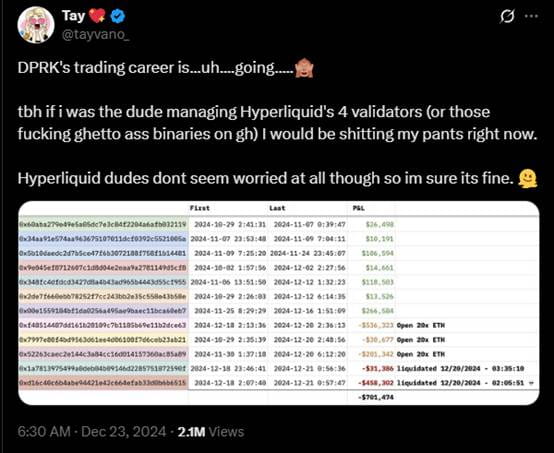In more than two and a half years, Hyperliquid has established a leading position in the decentralized perpetual contract market. Just counting the top 100 perpetual contract trading pairs, last week, Hyperliquid's perpetual contract trading volume had formed an '82 to 18' ratio with Binance's perpetual contract trading volume in USD.
To achieve such success, Hyperliquid's core team consists of only 11 people. On August 20, HyperliquidFR released data showing that Hyperliquid generated an average annual revenue of $102.4 million per employee, making it the company with the highest revenue per capita globally.
Looking back at Hyperliquid's journey, there have been periods of unnoticed dormancy, stunning airdrop wealth creation, and also times of low valleys. As $HYPE reaches its third historical high this year, let us review Hyperliquid's legendary journey together.
Dormancy
On December 27, 2022, Hyperliquid sent out its first tweet announcing the launch of the Hyperliquid L1 testnet.

During that almost unnoticed period of dormancy, Hyperliquid's founder Jeff was focused on building his underlying logic. He had engaged in quantitative and high-frequency trading research at Citadel, grew up in Silicon Valley after graduating from Harvard, understanding how traditional financial systems maintain matching efficiency and fund security under extreme pressure.
'How to give on-chain trading a Wall Street-level execution experience?' This is a question Jeff has been pondering. Against this backdrop, Jeff did not choose to build a contract trading platform on existing public chains, but insisted on building a new Layer 1, putting the entire matching, clearing, and risk control systems in his own hands.
In the following months, Hyperliquid's official Twitter account saw little significant progress. On April 20, 2023, Hyperliquid's tweet announced that referral rewards were issued to 81 addresses. A user in the comments expressed happiness at earning a $3 reward, but surely later, such early participation brought him returns far exceeding that $3. It is unknown whether he imagined a bright future at that time.

On May 17, 2023, Hyperliquid announced the launch of the community's native market-making vault 'HLP', which became Hyperliquid's first tweet to receive significant attention. Now, HLP's TVL has reached approximately $573 million.

On June 17, 2023, HLP suffered its first attack. The attacker manipulated the price of $SNX on CEX, sold $SNX on Hyperliquid, and then closed the position on CEX, making a profit of about $37,000. Hyperliquid quickly made adjustments, and by this time, it must have foreseen that as Hyperliquid developed, HLP would face more challenges.

On November 1, 2023, Hyperliquid launched a points system. On the 24th of the same month, Hyperliquid announced that the total trading volume of the platform reached $10 billion. By the year-end summary of 2023, Hyperliquid announced that the total trading volume had reached $21 billion, with over 31,000 users, and in the first week of 2024, the weekly trading volume surpassed dYdX, making it the top decentralized perpetual contract market.
It can be said that Hyperliquid has entered a phase of rapid development since then. The leading players are subtly surfacing, and the dormancy is about to end.
A stunning success
If the Jeff of the dormancy period was a dedicated engineer, then in 2024's 'stunning success' phase, he has begun to exhibit clearer strategic ambitions. Hyperliquid is not satisfied with merely occupying a leading position in the contract market; Jeff has emphasized in multiple occasions that he hopes Hyperliquid will become a 'fully functional financial ecosystem on-chain', rather than just a single Perp DEX.
Thus, on March 29, 2024, Hyperliquid announced it would support native spot trading and launched two native token standards, HIP-1 and HIP-2. HIP-1 is the native token protocol that allows users to issue custom tokens on Hyperliquid L1. HIP-2 is a liquidity solution providing market-making strategies for tokens issued under HIP-1, ensuring liquidity without relying on external platforms like Raydium.
At the same time, Hyperliquid also announced that the first token to be listed on the spot market would be a meme coin $PURR issued by itself on Hyperliquid L1. $PURR is the first gift for all users who participated in the Hyperliquid points system, and at its peak, the token's market value exceeded $600 million. It currently still has a market value of $108 million, remaining the largest native meme coin by market cap on Hyperliquid L1.
On May 20, 2024, Hyperliquid announced it would support native EVM, signaling that Hyperliquid was not satisfied with the success of contract products but had greater ambitions to build an ecosystem, hoping to possess the capability to allow users to fully embrace the Hyperliquid ecosystem without needing CEX or other blockchains.
On November 29, 2024, Hyperliquid's native token $HYPE was launched, closing at a price of $6.25 on its first day. Early users reaped substantial rewards, but even bigger surprises were ahead, as within less than half a month, $HYPE surged over five times, reaching a peak of $35.
Twitter was filled with discussions about $HYPE, and regardless of whether one was a contract player or not, people began to recognize Hyperliquid's existence.
Test
A big tree attracts the wind. Hyperliquid, which has been developing rapidly almost smoothly, soon faced its first test after the issuance of $HYPE.
On December 30, 2024, renowned security researcher Tay (@tayvano_) issued a tweet warning that multiple identified North Korean hacker addresses traded on Hyperliquid from October 29 to December 18, 2024, totaling losses of over $700,000.

Although Hyperliquid showed no signs of an attack at the time, this could also mean that Hyperliquid had already been viewed as a potential attack target by North Korean hackers. In the tweet, Tay also mentioned, 'If I were one of Hyperliquid's four validators, I would be scared to death,' which sparked discussions in the market about the potential security issues due to Hyperliquid's insufficient number of validators.
A day later, according to an official announcement, Hyperliquid Labs stated that they had become aware of reports regarding the so-called activities of North Korean hacker addresses. In fact, Hyperliquid did not suffer any attacks from North Korean hackers—nor did any form of attack take place. All user funds have been properly managed.
On January 7, 2025, node operator Chorus One published an open letter on Twitter, detailing multiple issues with the Hyperliquid testnet, including frequent node shutdowns, operational difficulties caused by closed-source code, and single-point failure risks brought by centralized APIs, along with several improvement suggestions aimed at enhancing chain transparency and decentralization.
In response to these concerns, Hyperliquid founder Jeff replied and emphasized that the validator selection criteria were explained in the announcement; the official Hyperliquid account also separately posted on the X platform to clarify the issues mentioned in the letter and stated that the node code would be open-sourced under safe conditions.
On March 27, 2025, Hyperliquid fell into a significant trouble that caught market attention. A whale on-chain established a large number of short positions in JELLY, and the sudden price volatility of the JELLY token led to its liquidation. After the takeover of the positions by Hyperliquid's counterpart vault, the entire protocol vault faced a risk of going to zero. At the same time, CEXs also seized the opportunity, launching JELLY contracts to target and hunt down Hyperliquid.
The incident concluded with Hyperliquid delisting the JELLY token and settling the assumed short position at a price of $0.0095 (far below the market price) without losing any funds. However, the FUD (Fear, Uncertainty, Doubt) continues. Arthur Hayes stated on Twitter that Hyperliquid was unable to handle the JELLY incident, claiming it was not decentralized at all, and dared to bet that $HYPE would soon fall back to its original point. Bitget CEO Gracy Chen further stated that Hyperliquid's handling of the incident was immature, unethical, and unprofessional, and Hyperliquid could become FTX 2.0.
This incident did not hinder Hyperliquid's progress. After the first week of April, $HYPE began to regain momentum and continually set new historical highs.
Whale Preference
In March 2025, Hyperliquid first gained market attention due to the operations of a whale. At that time, a 'Hyperliquid 50x leverage whale' emerged, widely noticed for its high win rate and massive profits through high leverage trading, and thus was referred to as the 'Insider Guy'.
In May, James Wynn and the 'Insider Guy' staged a long-short showdown, with James Wynn's position once exceeding one billion dollars, ultimately leading to his victory.
But soon, he also faced a huge setback. James Wynn had profits as high as $87 million at the end of May, only to later lose all his profits and incur a loss of $21.77 million in principal. At his peak at the end of May, he opened a position worth $1.23 billion in BTC long on Hyperliquid.
Regardless of whether the whales succeed or fail, the movements of the whales on Hyperliquid have already become one of the important barometers of the market, becoming a living symbol of Hyperliquid.
Two days ago, according to on-chain data analysis from Arkham, a giant whale, also a recent market focus known as the 'ancient whale who sleepily swapped BTC for ETH after seven years', staked ETH worth $1.25 billion again. So far, this unknown whale has purchased $2.55 billion worth of ETH through Hyperliquid (Hyperunit) and staked it all.
With so much ETH, this whale has already ranked in the top 10 of the ETH total holdings on Ethscan, approximately 2.5 times the current ETH holdings of the Ethereum Foundation. This whale had a significant impact on Bitcoin's market, causing a 3% drop due to the sell-off. Perhaps wanting to maintain mystery, this whale used Hyperliquid for operations.
Providing a CeFi-level trading experience on a fully decentralized Layer 1, Hyperliquid achieved this, which is the core reason for its preference among whales.
Conclusion
The crypto space is indeed a place where miracles happen. Considering that Hyperliquid is challenging giants like Binance and OKX, and looking at Hyperliquid's development speed and revenue scale, it is hard not to be amazed; Hyperliquid is another 'crypto miracle'.
Reflecting on this journey of Hyperliquid, it is easy for people to focus on those dazzling numbers and stories. However, if you pull the lens closer, you will find that the essence of Hyperliquid is actually Jeff's essence.
Jeff is not a founder who likes to frequently appear in public; he rarely accepts interviews and almost never engages in excessive marketing. In a recent interview, he mentioned that Hyperliquid has only 11 team members and no marketing team internally.
Behind the beautiful story, Hyperliquid also experienced an unknown period of dormancy and growth, facing various doubts and tests. And now, they continue to persevere and will continue to reap rewards.



